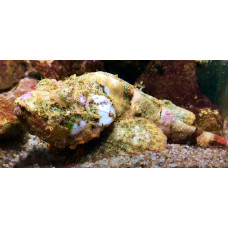Latin name
Scorpaenopsis neglecta
Other names
Bandtail scorpionfish
Identification
These fish have a very high curved hair and front part of the body, giving them a humpbacked appearance. They have a large distance between the eyes. The occipital process has 1 or 2 additional spines and the anterior margin of the lacrimal bone is serrate. The supraorbital, inferior temporal and second suborbital processes are replaced by ridges. There is a serrated prominence above the eye.
Features of fish fins
The dorsal fin has 12 spines and 9 soft rays, while the anal fin has 3 spines and 5 soft rays.
Fish colouring
The pattern of this scorpionfish consists of spots and feathers that camouflage it. A dark reddish stripe runs along the outer part of the tail, just off the edge, and there is often a yellowish spot on the cap. The inner surface of the pectoral fin has no dark spots and has a black stripe across the upper rays at their tips with small dark spots where the pectoral fin joins the body.
Distribution
Widespread in the Indo-West Pacific, extending westward from India and Sri Lanka, eastward to New Caledonia, northward to southern Japan, and southward to northern Australia, where they are found from Shark Bay in Western Australia to Wollongong in New South Wales.
Habitat
A tropical marine benthic species. They live on rocks and coral reefs in shallow water and on sandy and muddy surfaces at depths down to 40 m (130 ft).
Size
This species reaches a maximum standard length of 19 centimeters (7.5 inches).
Behavior
It is usually a solitary species. They are masters of camouflage, which allows them to stalk their victims at close range, then lunge forward and swallow their prey with their large mouth. When disturbed, they raise their spines along their back and usually run away to do no harm, but if cornered they are capable of attacking with considerable speed.
Food and feeding habits
Carnivorous fish prey on other fish, crustaceans, mollusks, and other invertebrates.
Reproduction
Before mating, the fish release a buoyant mass into which they place their eggs. The female then releases 2,000 to 15,000 eggs for the male to fertilize. As the eggs float away, the mating pair quickly hides to avoid attracting the attention of predators.
Fishing
Not interesting for fishermen.
Relationship with a person
These fish have venom glands in the spines of their fins.
| Classification | |
| Phylum | Chordata |
| Class | Actinopterygii |
| Squad | Scorpaeniformes |
| Family | Scorpaenidae |
| Genus | Scorpaenopsis |
| Species | S. neglecta |
| Features | |
| Conservation status | Least Concern |
| Habitat | Pelagic |
| Life span, years | No information |
| Maximum body weight, kg | No information |
| Maximum length, cm | 19 |
| Sailing speed, m/s | No information |
| Threat to people | Not edible |
| Way of eating | Predator |
Yellowfin scorpionfish
Tags: yellowfin scorpionfish



